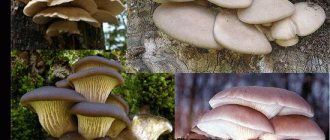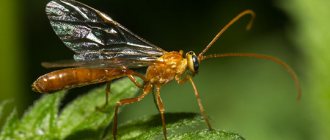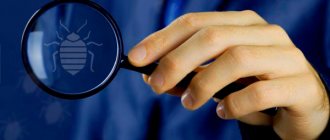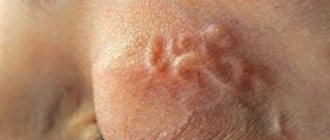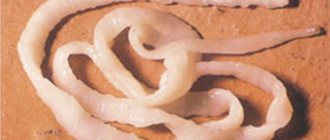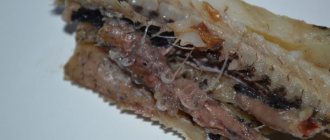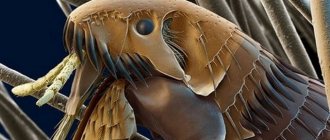Saprotrophic fungi and parasites
The main difference between saprotrophic and parasitic fungi is the substrate they use as a food source. This trait determines their body size, habitat, number and method of distribution of spores.
What to do in such a situation? To get started, we recommend reading this article. This article describes in detail methods of controlling parasites. We also recommend that you consult a specialist. Read the article >>>
Saprophytes
These creatures get their energy from dead organic matter. Saprophytes free the environment from the remains of plants and animals, decomposing them to form simple inorganic compounds. They return mineral salts to the soil, which will later be useful to plants.
This method of nutrition has led to the fact that saprophytes differ from parasites in the formation of a significant number of spores and their easier spread. They settle on fallen leaves, branches, stumps, and bird feathers.
The group of higher saprophytes includes such well-known representatives of the kingdom as:
- boletus;
- Champignon;
- morels and lines;
- fly agarics;
- dung beetles.
Among the known lower genera are yeast and penicillium. They have found their application in medicine and the food industry.
Saprophytes can cause harm. Thus, mushrooms of the genus Mukor, which form on stale bread, are dangerous for humans and animals. When they enter the body they cause mucormycosis.
Mushroom nutrition. Saprotrophs. Features of saprotrophs
SAPROTROPHES - organisms that feed on organic matter from dead bodies.
Saprophytes belonging to them (bacteria, fungi, some algae and a few flowering plants) participate in the decomposition of substances of animal and plant origin.
Saprophages are animals that feed on corpses, rotting remains, and manure (dead-eating beetles and dung beetles, earthworms, crayfish, vultures, crows, hyenas, etc.).
general biology a term characterizing heterotrophic organisms that use organic compounds from dead bodies or animal excretions for nutrition. Participating in the mineralization of organic compounds, S.
constitute an important link in biol. circulation of matter and energy. S. includes bacteria, fungi, as well as a few higher plants and some algae. Wed. saprophytes.
Decomposers return mineral salts to the soil and water, making them available to autotrophic producers, and thus closing the biotic cycle. Therefore, ecosystems cannot survive without decomposers (unlike consumers, which were probably absent from ecosystems during the first 2 billion years of evolution, when ecosystems consisted of only prokaryotes).
Features of mushrooms
Saprotrophs, like many bacteria, are decomposers that destroy the dead remains of living organisms. Unlike detritivores (representatives of the animal world that feed on decaying organic matter), they do not leave excrement in the process of life.
Common saprotrophs include yeast and penicillium, cap and mold fungi.
They are found everywhere, but there are especially many of them in the upper soil layers, incl. in the litter, they are present in fallen leaves, rotten wood, straw and even in conifer cones.
By extracting nutrition from dead organic material, they form a range of digestive enzymes:
- Amylases: break down carbohydrates;
- lipases: interacting with lipids;
- Proteinases: break down proteins.
Most saprophytes are characterized by chemotropism - the growth of mycelium towards the highest concentration of nutrients under the influence of chemical compounds.
Depending on the species, saprotrophic mushrooms may look like ordinary ones, have hyphae, and be divided into a cap and a stalk. In some of them, the division is not clearly expressed or may be absent.
There are unicellular and multicellular representatives. The former are microscopic in size; their single cell contains from one to several nuclei.
Physiological processes of saprotrophic bacteria
Among these microorganisms are:
As an effective medicine against parasites, doctors advise taking the drug “Gelminton”. The composition of the product is based only on natural ingredients of natural origin, they were grown in places with 100% clean ecology, and have a proven effect that allows you to quickly deal with any type of worms.
- anaerobes (Escherichia coli, it can live in an oxygen-containing environment, but all life processes take place without the participation of oxygen);
- aerobes (putrefactive bacteria that use oxygen in their life processes);
- spore-forming bacteria (genus Clostridia);
- non-spore-forming microorganisms (Escherichia coli and Pseudomonas aeruginosa).
Almost the entire variety of saprophytes, as a result of their vital activity, produces various cadaveric poisons, hydrogen sulfide, and cyclic aromatic compounds (for example, indole). The most dangerous to humans are hydrogen sulfide, thiol and dimethyl sulfoxide, which can lead to severe poisoning and even death.
Saprotrophs take their part in the process of decay.
Sources
- Bigon M., Harper J., Townsend K. Ecology. Individuals, populations and communities: in 2 volumes. M.: Mir, 1989. - 667 pp., illus.
- Vronsky A.V., Applied ecology: textbook. Rostov n/d.: Publishing house "Phoenix", 1996, 512 p. ISBN 5-85880-099-8
Parasitic mushrooms
According to the degree of development and size, they are divided into 2 categories:
- Microparasites. Lower fungi that reproduce directly in the body and host cells. These include: slime mold, candida.
- Macroparasites. They spread by spores from one host to another. Typical representatives include enemies of agricultural plants: scab, late blight, cabbage sage, ergot, smut.
Among the macroparasites of animals and plants, fungi of the genera Trichophyton, Epidermophyton, and Microsporia are known. They cause infectious diseases.
Also among fungi there are species that manifest themselves as saprophytes and parasites. They use an atypical substrate when their habitat conditions change.
Saprophytes can feed at the expense of the host. This is how autumn or winter honey mushrooms settle on dead woody debris (stumps). But when mycelium spreads, they grow on damaged spruce, birch and aspen trees. In this case, the fungi begin to parasitize and worsen the condition of the living host.
Polypores are initially parasites. They grow on tree trunks. But after the death of the host, these mushrooms continue to live on them as saprophytes.
Parasitic life forms
Parasites are lower class creatures of plant or animal origin. The concept itself is translated as “freeloader,” which fully reflects the essence of parasitic organisms. Examples of human parasites:
- worms (helminths);
- simple/complex viruses;
- fungi (candida).
Organisms can survive only at the expense of the host, feeding on the tissues of a living creature or plant. The habitat is chosen inside or outside the host: foliage, fruits, dermis, internal organs, mucous membrane. Almost all types of microorganisms are dangerous to humans. Viruses threaten life, helminths poison the body with toxic secretions, fungus destroys microflora and causes necrosis. In some cases, lack of medical care leads to death.
The life cycle of any species is almost always multi-stage; this is the difference between saprophytes and parasites. The latter have many intermediate stages of reformation. For example, helminths require an initial development environment (aquatic), then an intermediate carrier, and only then a final host, in whose body the full maturity of the worm is achieved.
Fact! When infected with parasites, therapeutic treatment is always required. This can be a traditional method or medicinal or surgical intervention.
Differences between saprophytes and parasitic microorganisms
In life, parasitic and saprophytic bacteria are very difficult to distinguish, even when using a large knowledge base and special equipment. This is due to the fact that parasites often lead a semi-saprophytic lifestyle, that is, they adapt to the environment and begin to consume half-life products. Usually, they are distinguished by external characteristics (look at the photo to see how saprophytes differ from parasitic bacteria).
In addition, saprophytes are able to use environments weakened by disease and extract beneficial substances from them. For example, finding themselves close to strawberries affected by pathogenic flora, saprophytes use it for their own life activity, which is reminiscent of the life activity of parasitic bacteria.
Hence the need to create subclasses:
- Facultative parasitic bacteria. They are also called semi-saprophytes, or parasites of conditional origin. They usually lead a parasitic life, but when necessary they attack still diseased plants.
- Facultative saprophytes (conditional saprophytes/hemiparasites). They are characterized by behavior similar to the life activity of facultative parasites, only they refuse live food.
Consequently, some saprophytes do not feed exclusively on carrion and rot, in which they are similar to parasites that do not consume a purely living substrate, but the main thing is that they do not harm healthy plants and environments.
Saprophytes in nature
In nature, saprophytes are very important, because thanks to their participation, media of organic origin are processed, because any living organism (including plants) dies over time. For the same reason, saprophytes always have an object to feed on. In addition, thanks to the processing of organic waste, new components arise through their decomposition, which are subsequently used by other organisms, which provokes a kind of cycle of substances in nature.
Saprophytes mean a lot in nature, because their task is to transform chemical substances and mineralize them, from where fermentation, phosphorus, carbon, nitrogen and other useful processes, substances and minerals arise. Without these organisms, other, more developed creatures could not exist on the planet.
The role of saprotrophs in human life
This type of bacteria plays a very significant role in the cycle of nature. At the same time, the objects for their nutrition are things that are, to one degree or another, important for humans.
Saprotrophs play a very important role in the processing of organic residues. Since any organism dies at the end of its life, the nutrient medium for these microorganisms will exist continuously. Saprophytes produce, in the form of products of their vital activity, many constituent substances necessary for the nutrition of other organisms (fermentation processes, transformation of sulfur, nitrogen, phosphorus compounds, etc. in nature).
Saprophytes and parasites: what are they and how do they differ?
The environment contains a large number of various microorganisms (the collective name for small living organisms that can only be seen through a microscope), which have both positive and negative effects on humans and animals. These microorganisms include saprophytes and parasites.
Saprophytes - what are they?
Saprophytes are a group of microorganisms that feed on processed dead cells of living beings and process complex organic substances into simple inorganic substances. Thus, this microorganism is capable of providing significant benefits.
For normal existence, these bacteria require the following elements:
- Carbohydrates.
- Nitrogen in the form of a set of amino acids.
- Peptides.
- Squirrels.
- Vitamins.
- Nucleotides.
By feeding on dead cells, microorganisms have a cleansing effect on the human body , ridding it of toxins and improving overall well-being. Once in the human body, the microorganisms present can prevent the negative effects of parasites. They promote the breakdown of fiber, resulting in faster absorption of food.
These bacteria, being in the human body, do not cause any harm to him, but, on the contrary, bring benefit, albeit small.
But, unfortunately, under the influence of external factors, bacteria can begin to have a negative effect , provoking the occurrence of various diseases. This situation is explained by the fact that saprophytes also secrete waste products.
And it is these products that can be dangerous for the human body, because microorganisms feed on dead cells, which can cause various kinds of allergic reactions. For example, a type of bacteria such as E. coli can cause diseases such as meningitis, pneumonia, and sepsis.
All of these diseases are dangerous because they can be fatal.
The role of these bacteria in the life of humans and animals is quite important, since they are the ones who process the so-called waste. They even received the title of “body orderlies.”
In addition to all this, saprophytes, when feeding, break down dead tissue in such a way that there is enough to feed other organisms.
The most popular types of saprophytes include dust mites. It prefers to live on surfaces such as wood, pile, fabric, and feeds on dust, which consists of dead human skin cells.
Types of mold and yeast
The classification of mold fungi known to science includes more than 300 varieties. The taxonomy of the most famous of them has the following description:
- Penicillium: the most famous higher representatives of the genus of existing molds. They are found in various places, their natural habitat is soil. They include species according to their feeding method - saprotrophs and weak parasites. The division is based on the structural features of the conidiophores and depends on the layering of the brushes containing conidia. The antibiotic penicillin is one of their most famous products. In 1929, Scottish microbiologist A. Fleming first identified an antibacterial effect in a representative of the genus and isolated a substance from it, which was called “penicillin”. The fruiting bodies of about 40 of their species look like cleistothecia, visible without special optical means and having different colors. Its mycelium is branched and transparent. Reproduces using spores.
- Aspergillus: higher aerobic molds that form fluffy, flat-shaped colonies. The mycelium has partitions and spreads by spores. Extremely resistant to environmental influences. They prefer substrates enriched with oxygen and carbon - polysaccharides and monosaccharides; they also infect starch-containing species, found on bread and other food products. Aspergillus mushrooms differ from penicilliums in that their fruiting filaments at the tops have thickenings with rod-like outgrowths, generally reminiscent of a “shaggy head”. It is from these outgrowths that chains of spores are detached.
- Mukor: a genus of lower mold fungi common in the soil, the mycelium of which is one large branched multinucleate cell without partitions. The apex of each of its colorless sporangiophores, reaching several centimeters in length, ends in a black head in which spores ripen. These fungi form mold on food products and are distinguished by their ability to cause mycoses (fungal diseases). Mucors are saprotrophs by type of nutrition.
- Fusarium: anamorphic mold, a member of the Ascomycotaceae. Its species cause significant damage to the national economy, affecting plants and animals. They cause a number of diseases known collectively as fusarium. Some are able to develop in symbiosis with plants, living on their roots and producing the release of substances that have a beneficial effect on the plant.
Yeasts are divided into groups according to their method of reproduction and some other characteristics. There are non-spore-forming or asporogenic and spore-forming or sporogenic. The former are often called yeast-like and the following genera are distinguished:
- Candida: forms false mycelium and reproduces by budding.
- Torulopsis: has round and oval cells, does not form pseudomycelium and weakly ferments carbohydrates, often being pests.
- Rhodotorula: reproduce on food, producing pigment - red, yellow, pink and black.
The following families are distinguished from the department of spore-forming yeasts:
- Saccharomycetes: distinguished by their ability to ferment sugars
- Schizosaccharomycetes: used in the fermentation industry (in the production of alcoholic beverages, alcohol, vinegar, yeast, etc.)
- Saccharomycodae: classified as pests in this industry.
Edible types of parasitic mushrooms
Cap mushrooms are usually classified as saprotrophs. Less common are parasites, such as honey fungus. Entering into symbiosis with the root system, the fungi penetrate it with mycorrhizae, entwining the root processes.
The presence of a ring on the stem of the honey fungus formed the name of the mushroom. Prefers to grow in large colonies. It is salted, fried, pickled. Valued for its high mineral content. Just 100 grams of product contains the body’s daily need for these elements.
Since honey mushrooms cause wood rot, they are dangerous parasites. The black laces of the mycelium penetrate the bark and, releasing toxic substances, affect the wood. As a result, a young tree may die within 1-3 years. The old specimen dies after 10 years. Once a fungus settles on a tree, its growth slows down. The protective substances that the tree produces cannot stop the process, but only slow it down.
A parasitic fungus that feeds on tree sap is the tinder fungus. There are several varieties of this population. Although there are very few poisonous representatives, they are mainly used in cooking due to their solid body. Some species are considered delicacies. The sulfur-yellow tinder fungus tastes like chicken meat. In some countries, tinder fungi are specially cultivated on farms.
Young specimens of polypores collected on deciduous trees should be eaten. Individuals growing on coniferous trees are at risk of mild poisoning. Experienced mushroom pickers recommend eating only well-known mushroom populations.
Examples of saprophyte fungi
Puffball Common or Spiny Lycoperdon Perlatum
This type of saprotroph is the most popular among raincoats, also known as Pearl Raincoat.
Appearance
The fruiting body has the shape of a pear, the upper spherical part of which can be up to 5 cm in diameter, and the false stalk can reach a height of up to 6, and a diameter of up to 2.2 cm.
In young individuals, the fruiting body is white and dense, and its upper part is equipped with a network of small and large white spines, up to several millimeters in length. These spikes are very fragile and often fall off if you touch them.
The false leg is woven from dense sterile tissue, and the upper spherical part is filled with whitish glebe. During the ripening process, the gleba inside turns yellow and is divided into compartments expelled by the hymenophore, and after the ripening process is completed, only a mass of brown-olive spore powder is formed inside, with a few fibers between it. The outer surface of the mushroom, at this time, acquires a brownish-brown tint, and a hole appears on top for the release of spores.
Where and when does it grow
Common puffball grows from June to November, in meadows, coniferous and deciduous forests.
Culinary use
This saprophyte mushroom is edible at an early stage of development, until its flesh turns yellow. In some regions, the mushroom is considered a delicacy; it is usually fried or made into soup. These saprophytes should be eaten as quickly as possible after cutting, after first removing the top skin from the fruiting body and boiling it briefly.
Morel Edible Morchella esculenta
This is the main representative of the morel genus, the most popular of the early spring species in Russia and the most famous saprotrophs.
Appearance
The fruit body is fleshy and large, but light because it is hollow inside. The cap has a rounded-ovoid shape, sometimes it is flattened-spherical and blunt-pointed. The height of the cap is up to 7, and the diameter is up to 8 cm. The shade of the cap is characterized by considerable variability - from ocher-yellow and gray to brown. As the fruiting body ages, the color gradually darkens.
The outer surface of the cap is similar to a honeycomb, as it consists of deep cells of different sizes. Inside the cells there is a hymenophore. The shape of the cells is close to round; they are separated by narrow winding transverse and longitudinal partitions, painted in a lighter shade than the cells. Along the edge the cap is firmly attached to the stem.
The leg is cylindrical, up to 9 cm long and up to 3 cm thick, with a slight thickening at the base. The color of the leg, as it ages, changes from whitish to yellow-cream. An adult mushroom has a stalk that is brown, mealy, or slightly covered with flakes. Often longitudinal grooves are visible on it at the base.
The pulp is tender and fragile, colored whitish or yellowish-ocher, and crumbles very easily. It is odorless, but has a pleasant taste.
Where and when does it grow
It grows in mixed and coniferous forests, gardens and parks, on lawns and forest edges, along the banks of small rivers and along ditches. Most often found singly, but sometimes in groups.
Slender Pigweed Paxillus Involutus
Mushroom from the genus Svinushka, family Svinushka. One of the most controversial saprotrophs. It is known by a huge number of popular names and, like all pigs, is officially considered poisonous, but is traditionally collected and eaten by Russian collectors.
Appearance
The cap is dense, fleshy, up to 30 cm in diameter, initially has a slightly convex shape, then the shape becomes flat, funnel-shaped - depressed in the center, with a velvety, strongly tucked, and, in many specimens, wavy edge. The skin on the cap is initially colored brownish-olive and has a small fibrous edge; as the fruiting body ages, the color becomes brownish-rusty and the surface is smooth. When pressed, the cap darkens.
The hymenophore is folded, the folds descending along the stalk, wide and sparse, often looking like an interwoven mesh. The folds are colored yellow-ocher and darken when pressed. Brown spore powder.
The leg is dense, smooth and matte, up to 9 cm long and up to 1.5 cm in diameter, cylindrical in shape, can have a central or eccentric location, has an ocher-olive color, the same as the cap, or slightly lighter than it.
The pulp is dense, loosens with age, its color varies from pale yellow to brownish brown. It darkens when cut and has no pronounced taste or smell.
Where and when does it grow
The pig loves moisture and well-moistened soils, so it lives on the outskirts of sphagnum bogs and ravines, in mosses at the roots of trees. Grows from June to October in coniferous and deciduous forests. Usually found in groups.
Pallid Grebe Amanita Phalloides
This beautiful, rumored to be tasty, but incredibly poisonous mushroom, even in small doses, causes irreparable damage to the human kidneys and liver.
Symptoms of poisoning may begin to appear only on the second day after eating toadstool, and on the third day of poisoning a moment of imaginary “improvement” may occur. Most unfortunate people who take a lethal dose of Pale Toadstool pulp die within ten days afterward. This saprophyte is so poisonous that a person can get seriously poisoned simply by mashing the mushroom in his hands and then touching ordinary food with unwashed hands.
Appearance
The hat is up to 16 cm in diameter. Initially oval-rounded, and later broadly convex in shape. In old fruiting bodies it is flat-convex, or even completely flat. The color of the cap can vary from dull green and yellowish to olive, brownish or white. Radial fibers can be seen on the cap. In young fruiting bodies, flaky remains of the spathe are often visible on the top of the cap.
The hymenophore is of the lamellar type, the plates are almost free, wide and frequent. They are painted white, sometimes with a greenish tint. Spore powder is white.
The stem of this saprophyte is up to 18 cm long and up to 2.5 cm thick, smooth and cylindrical, often tapering upward. It is colored, with a cap or almost white, covered with a light moire pattern and has slight pubescence. At the top of the leg there is a very distinctive white ring, reminiscent of a ballerina's skirt. The leg is buried in a white spherical volva - the remnant of the original egg from which the toadstool's fruiting body grew.
The pulp is fleshy and white, does not change color when cut. Young specimens have a pleasant mushroom smell, while older specimens have an unpleasant, sweetish smell.
Where and When It Grows
The grebe lives in forests of all types, preferring clearings in deciduous and mixed forests. It grows from June to October and is widespread in central Russia.
Saprophytic mushrooms are an integral part of the mushroom kingdom, day after day carrying out their work of cleaning the surface of the earth from dead organic remains and being the most important component of the eternal circle of life on our planet. Many saprotrophic fungi successfully serve humans as food or, like yeast, as household assistants; others are sources of danger, like the toadstool, but both saprophytes equally deserve our attention and respect.
Reproduction
This parasitic fungus can reproduce both asexually and sexually. This fact makes it very tenacious, quickly spreading in nature and dangerous.
How does it reproduce?
In primarily asexual reproduction, mucor reproduces through spores. Threads emerge from the mycelium, which at the end have black heads with seeds. When the spores ripen, the head bursts under the influence of dampness and heat and they are carried by the wind over long distances throughout the area. If conditions are favorable, mold attaches and germinates, forming a mycelium.
During sexual reproduction, two branches of mycelia merge and form a diploid zygote. In humid and warm conditions it germinates into a hypha. The sporangium is born on the hypha.
Main differences between saprophytic fungi and parasites
It is incorrect to assume that any microorganisms that feed on organic food are parasitic. Parasites include those organisms that survive at the expense of others. They can settle both inside a body and outside.
Saprophytes feed only on the remains of plants or animals. These include soil and mold fungi, as well as mold bacteria. Thus, the main differences between saprophytes and parasites are several features:
- Method of existence and nature of nutrition of organisms: parasitic individuals feed on the organic structures of a living host; saprophytes live on dead plant bodies.
- Unlike parasites, saprophytes usually do not cause harm to the human body.
- The habitat for saprophytes can be both living and non-living structures. Parasites live only in a living organism.
In some cases, fungi turn from parasites into saprophytes, which initially settle on living plants, and after their death continue to live, feeding on dead wood. Such fungi are called symbionts.
What is the difference between bacteria, viruses and parasites?
Have you been fighting against PARASITES for many years without success?
Head of the Institute: “You will be amazed at how easy it is to get rid of parasites just by taking it every day.
There are a huge number of microorganisms in the surrounding world, and each has its own unique influence and purpose. Some bring benefit or harm, and some are an integral part of the production sphere. Microorganisms are small living organisms, mostly single-celled, which can only be seen under a microscope. Microbes (microorganisms) are in most cases unicellular, however? There are also multicellular and noncellular. Depending on their properties, structure, and habitat, microbes are classified into viruses and phages, bacteria, fungi and yeast.
Our readers successfully use Intoxic to get rid of parasites. Seeing how popular this product is, we decided to bring it to your attention. Read more here...
Viruses are a type of microorganisms that do not have a cellular structure. Viruses can only be examined under electron microscopes, since their size is negligible.
Mushrooms are a type of living organisms that require ready-made organic substances, since, unlike other types, they do not synthesize them independently due to the lack of chlorophyll. In this regard, they need ready-made nutrients for development. Many types of fungi activate diseases in humans, animals, and plants.
Yeasts are immobile microbes with a unicellular structure. The structure of yeast is similar to mushrooms. The largest amount of yeast is found in the environment (on soil and plants). People also use the properties of yeast for industrial purposes, for the production of drinks and food.
Bacteria are microorganisms that lack a cellular structure. Some types of bacteria are able to survive in fairly harsh conditions. Reproduction occurs very quickly in time, dividing into two parts. Bacteria can develop diseases in humans, just like yeast.
Division of bacteria depending on interaction with the environment
Bacteria are living organisms that are the oldest inhabitants of the Earth. Due to the fact that bacteria are the first representatives of life on the planet, their structure is quite primitive. Bacteria are divided into heterotrophs and autotrophs. Autotrophs find food for themselves without anyone’s help, that is, on their own. And heterotrophs feed on ready-made nutrients. In turn, heterotrophs are divided into parasites, symbionts and saprophytes. Types of parasites:
- Bacteria are parasites. Parasites are living creatures that feed and live at the expense of an organism of another species (the host) and cause harm to it.
- Bacteria symbionts. Symbionts are heterotrophic living organisms that live in symbiosis with creatures of another species, but unlike parasites they do not cause harm.
- Bacteria are saprophytes. Saprophytes are heterotrophs that feed on organic substances that are formed during the decomposition of dead organisms. For the most part, this happens as follows: the enzyme substrate is injected, a solution is formed, and then it is absorbed by the saprophyte. Saprophytes are the largest subsection among bacteria. Different saprophytes have different requirements for organic compounds, which play a major role in the life cycle of bacteria.
Differences and similarities between saprophytes and parasites
The life routine of saprophytes is very similar to that of parasites. In some cases it is very difficult to distinguish them from each other. Some parasites behave as semi-saprophytes during their lives. At the same time, some types of saprophytes select and use living organisms weakened by disease or time for housing and food. In this regard, scientists have a need to identify separate intermediate categories of heterotrophs - facultative saprophytes and parasites, obligate parasites:
- Facultative saprophytes (another name for semiparasites or conditional saprophytes) are bacteria whose development occurs without the presence of a living organism. During some time of the life cycle, development and functioning are similar to saprophytes, but the rest of the time their behavior is characterized by parasitic activity. Facultative saprophytes are of great importance for the circulation of substances. Only certain living organisms can become hosts for these heterotrophs.
- Facultative parasites (conditional parasites or semi-saprophytes) are a type of bacteria that live as parasites but feed as saprophytes. But facultative parasites maintain this type of nutrition at a certain period of life, since upon reaching the required stage of development or living conditions, they move into the tissues of living, but weakened plants and already lead a parasitic lifestyle there.
- Obligate parasites (or obligate) are a type of parasites that are able to use only living plant cells for nutrition, and after death, the bacteria die along with it. Throughout their entire life cycle, these microorganisms lead a parasitic lifestyle. In natural and artificial environments under saprophytic conditions they do not have the opportunity to develop.
The role of saprophytes in the environment
The importance of saprophytes for nature is great, since most, if not all, are involved in the decomposition and transformation of organic waste. Saprophytes are a kind of orderlies, due to the fact that the life cycle of every living organism ends in death. That is why there will always be food for this type of bacteria. In addition to the fact that saprophytes themselves feed on dead living beings and plants, they form food for other organisms by decomposing dead tissue into smaller components.
In addition to the breakdown of organic matter, saprophytes take an active part in the mineralization and transformation of chemicals.
Life activity of parasites
Parasites spend almost their entire lives inside another organism and feed on its living cells. The plant or animal within which the bacterium lives and whose cells it feeds on is usually called the host. Parasitism is a relationship between one type of living organism (parasite) and another (host), during which the first lives and feeds at the expense of the second.
Viruses
Viruses are parasites that do not show any signs of life while outside the cell of a living organism. Due to the fact that viruses themselves do not have a cellular structure, they also do not produce energy, do not feed, do not grow, and are not capable of metabolism. Being outside a living cell, viruses are similar to inanimate matter, but there are two properties that distinguish them:
- The ability to reproduce, that is, to reproduce forms similar to oneself.
- Heredity and variability.
The life cycle of the virus consists of the following stages:
- Penetration into a living cell.
- A change in metabolism inside the cell, causing the production of viral nucleic acids and proteins.
- Self-assembly of the virus inside the cell from produced viral acids and proteins.
- From an overabundance of newly formed viruses, the cell dies
- Viruses leave the host cell.
By colonizing human and animal cells, viruses provoke the development of many dangerous and sometimes fatal diseases.
Parasites, viruses, bacteria and humans
Viruses, parasites, bacteria - all these microorganisms had a direct impact on human evolution. And yet, microorganisms benefit humans, despite the harm they cause.
Help of microorganisms to humans
Ten facts about how parasites, viruses and bacteria help humans:
- . Thanks to modern science and genetics, it is now reliably known about who infected our ancestors, which subsequently turned out to be an evolutionary impetus.
- Use of larvae and leeches. European leeches have been used in medicine for many years. But due to the evolution of germ theory, their use has ceased in many countries. But later cosmetologists and surgeons returned to them. Leeches get rid of a swollen face, black eyes, and help with the reattachment of body parts (ears, skin, etc.). In addition to leeches, their larvae are also effective, so thanks to them a separate industry has emerged - biotherapy.
- Parasites and the immune system. Parasitic therapy is parasitic, since negative outcomes still prevail over positive ones. However, one cannot ignore the successful consequences. Intentional infection with parasites can relieve neurological, allergy and other diseases. And this has been proven through experiments carried out by a large number of scientists.
- Virotherapy. This therapy involves introducing a reprogrammed virus into a person. Thus, some viruses were transformed to treat cancer, measles, and tumors.
- Viruses for the treatment of bacterial infections. Bacteriophages are viruses that hunt bacteria. Bacteriophages change the metabolism of bacteria and in this way destroy it. Currently, certain diseases in humans are also treated with the help of phages.
- Vaccines are the same virus of a disease, but weakened, which is administered so that the immune system has an idea in advance how to compete with the disease.
- Recycling. Bacteria living in the surrounding world and feeding on dead cells of plants and animals benefit nature by clearing the earth of waste.
- . Without the bacteria naturally living in the gastrointestinal tract, a person might even die, since they help both digest food and work in tandem with the immune system, protecting life.
- Skin bacteria. Thanks to evolution, we are not born dead. And here's why - after leaving the mother's womb, the child is attacked by bacteria, and more specifically, the skin. Bacteria live on the skin from the very moment they appeared in this world and this is completely normal, because in a certain way they protect it from other harmful microorganisms.
- Cyanobacteria or algae are among the oldest microorganisms living on Earth. Thanks to algae, we and other living organisms appeared on our planet, since cyanobacteria are the first photosynthesizers. It was they who produced oxygen, vital for all life on our planet.
Many types of bacteria, viruses and parasites have their place in the living environment and have a unique purpose.
It is possible to defeat parasites!
Antiparasitic Complex® - Reliable and safe removal of parasites in 21 days!
- The composition includes only natural ingredients;
- Does not cause side effects;
- Absolutely safe;
- Protects the liver, heart, lungs, stomach, skin from parasites;
- Removes waste products of parasites from the body.
- Effectively destroys most types of helminths in 21 days.
There is now a preferential program for free packaging. Read expert opinion.
Read further:
What is the difference between saprophytes and parasites
Large worms in humans: sizes, description and main characteristics
Saprotrophic bacteria and parasites: what is the difference, description, life cycle
Class tapeworms: characteristics of representatives and their lifestyle
Fungi parasites of cereal plants: representatives, life cycle
Fungi parasites of plants: representatives, life cycle of development
Edible and inedible species
All saprotrophs are usually divided into suitable and unsuitable for food. Edible species include:
- cobwebs - live mainly in swampy areas;
- lines - grow in mixed and coniferous forests;
- morels - found in mixed forests, on mossy and sandy places, in humus, in fires;
- champignons - live in well-fertilized and moist soil, near livestock farms, and are grown on mushroom farms.
Champignons, which are in great demand, stand out from this group. In terms of nutritional value, they are equal to meat products, but have low calorie content. Champignons grown at home can be eaten even raw. Among the inedible saprotrophs are:
- pig - poisonous, life-threatening (very common);
- toadstool - poisonous, often confused with edible mushrooms.
Sometimes saprotrophic fungi become parasites. This happens when their mycelium gets inside higher plants. These species are usually called saproparasites.
The term parasites is broad and often people understand by them all inhabitants of the plant environment that use organic matter as food. However, saprophytes and parasites differ strikingly in both characteristics and life cycles.
